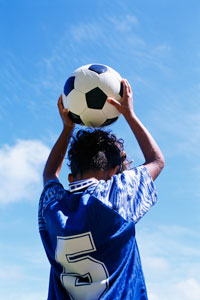By AOSSM

Childhood obesity has become one of the most widespread public health problems in the United States, and it has received tremendous media attention in recent years. Obesity in children and adolescents has also been thought to be a significant risk factor for cardiac disease, diabetes, and high blood pressure later in life.
Do American children meet the Guidelines?
Does much of the childhood population engage in 60 minutes of physical activity, and does that activity level increase or decrease over time? Laura Basterfield et al. published a study in the January 2011 edition of Pediatrics that showed that the physical activity levels of children are low. They found that the children averaged 26 minutes per day of moderate-to-vigorous physical activity at an average of 7 years old and 24 minutes per day at an average of 9 years old. Only 6.4% of children averaged the recommended 60 minutes per day of moderate-to-vigorous physical activity at age 7 and 5.7% did age 9.
A Proposed Solution
As gloomy as this data seems, there might be a fairly simple solution. Russell Jago et al. published a study in the February 2011 edition of Medicine & Science In Sports & Exercise looking at the influence of best friends on a child’s physical activity level. The authors determined that the physical activity levels of 10- to 11-year-old children were closely related to physical activity levels of their best friends.
Encouraging children and adolescents to get outside with their friends and play will largely meet the Physical Activity Guidelines. It really isn’t that complicated. There are numerous examples of activities that kids can do together that are both fun and also have aerobic, muscle-strengthening, and bone-strengthening properties.
For example, riding a bicycle or walking a dog can serve as moderate-intensity aerobic activity. Games with friends, such as playing tag, or more formal sports, are terrific ways to get vigorous-intensity aerobic activity. Likewise, playing on playground equipment, playing tug of war, or climbing a tree are muscle-strengthening activities, while push-ups, sit-ups, or more formal resistance training can be used by older adolescents. Impact sports and activities, such as running, jumping rope, and formal sports like tennis and volleyball can help strengthen bones.
It is important to remember that children and adolescents should meet these Guidelines with a variety of activities. Engaging in activities that stress different body parts will avoid overuse issues and decrease the chance of injury. The STOP Sports Injuries campaign aims to keep kids active in sports and exercise while decreasing injuries that can occur. There are a variety of resources available to parents, coaches, and physicians to educate them and promote safety in sports and other activities.
Patterns of low levels of activity and high levels of sedentary activity are established in childhood and only get worse as they get older. Let’s work to get kids outside playing with their friends, exercising, and playing sports to keep them healthy for life.
What are some other ways that each of us can work with our community, schools, employers and our own families to get kids outside and active more frequently?